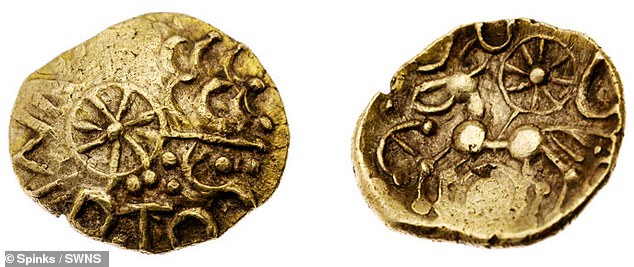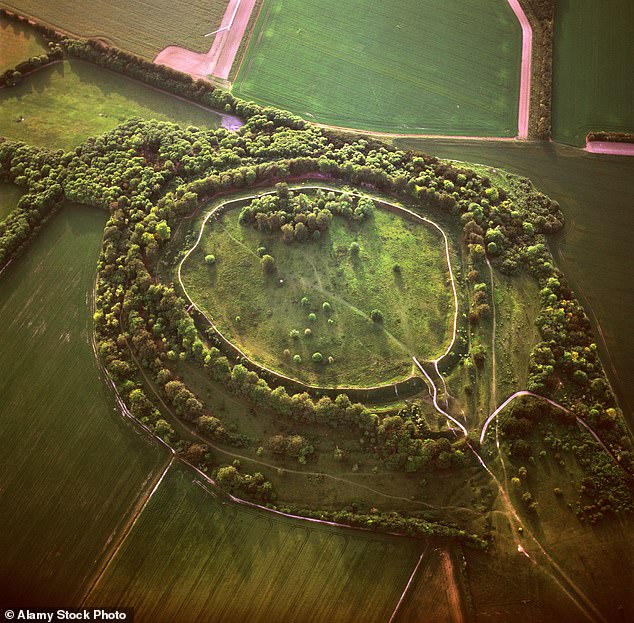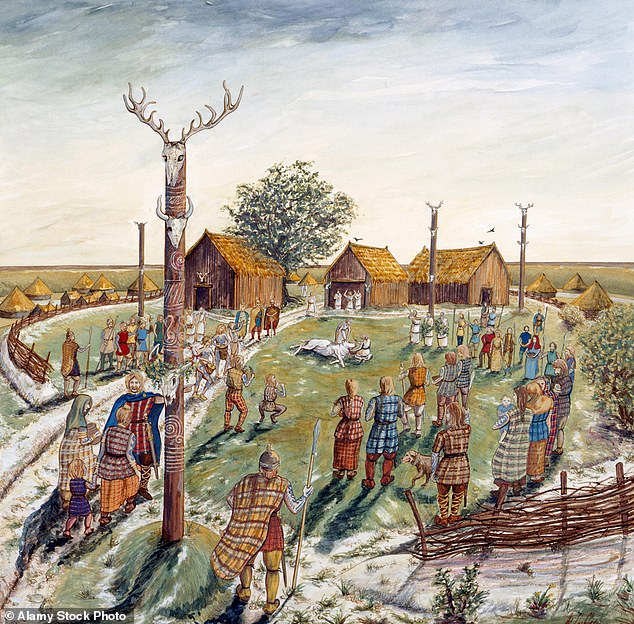A new British King? Gold coin discovered in Hampshire is stamped with the name ‘Esunertos’ – a previously unrecorded Iron Age ruler
>
British history may have been rewritten, after the discovery of a coin stamped with the name of a forgotten Iron Age ruler.
The coin was found by a metal detectorist in a field in Hampshire, stamped “Esunertos”.
Experts suggest that Isonertus may have ruled as king from Danbury Castle, and have described the discovery as “one of the landmark discoveries of recent decades.”
Initially, the gold coin was expected to fetch around £4,000 at auction.
However, it has set a new world record after selling for a staggering £20,400 this week.

British history may have been rewritten, after the discovery of a coin stamped with the name of a forgotten Iron Age ruler

The coin was unearthed by metal detectorist, Louis Fudge, in a farmer’s field in March this year after he obtained permission to unearth it.
The coin was unearthed by metal detectorist, Louis Fudge, in a farmer’s field in March this year after he obtained permission to unearth it.
“I’m very happy,” Fudge said. “If it wasn’t for the people in the auction room, I would have been jumping around.”
“The collectors I’ve spoken to are flabbergasted. I’m so glad I didn’t take up their special offers before the auction.
“To think that my discovery has created its own Wikipedia page is incredible.”
The coin is expected to fetch around £4,000, and frenzied bidding at auction house Spink has seen the price rise to £20,400, including premium, beating the world record for a similar type of coin, the Medusa quarter coin. Set at £10,800.
The coin was minted sometime between 50 and 30 BC, shortly after Julius Caesar’s first Roman raid on Britain in 55 BC.
He landed on the coast of Kent on board a fleet of ships carrying 20,000 Roman soldiers.
Thousands of Celtic warriors were waiting for them on shore, but the Romans were forced to return home after they struggled to land and their boats were destroyed by rough waves.

Experts suggest that Isonertus may have ruled as king from Danbury Castle (pictured), and have described the discovery as “one of the landmark discoveries of recent decades.”

An artist’s impression reveals what Danbury Hill Castle may have looked like in its early days
Caesar returned the following year with 50,000 soldiers, defeated several tribes, and marched all the way to the Thames.
But after three months of fighting, they left to stop a rebellion in Gaul.
Long-term settlement of Britain by Rome did not occur until AD 43, when Claudius was emperor.
Since then, leading Iron Age experts have studied the coin and concluded that it was struck by a prominent male figure dubbed “IISVNIRTOS,” whose name translates to “strong as the god Issus.”
One theory is that he may have ruled as king from nearby Danbury Hill Fort.
Dr John Sales, of the Ashmolean Museum’s Celtic Coin Index, said: “It is one of the landmark discoveries of recent decades in Celtic numismatics.”
Gregory Edmund, Iron Age coin specialist at Spink Auctions who led the team of experts in recording the new discovery, added: “This remarkable piece of prehistoric artwork completes the mental image we have when we think of Iron Age Britain – a horse.” War and chariot.
“But it also surprises us with the emergence of classical languages such as Latin.
“This is why I came to work: to document discoveries of national importance and to share that knowledge directly with museums, among academics, collectors and the public at large.
“On a personal level, this discovery is particularly vindicating for me.
“I focused my undergraduate degree on the Roman conquest of Britain through the lens of early British coinage.
“Adding a now critically important contemporary witness to those seismic events in the birth of our island story is exciting.”
“Despite the coin’s small size, the name of its designer – Esunertos – now resonates through the ages.
“Isonertus was once forgotten, but his name now looms large in the historical record.”
(tags for translation) Daily Mail
